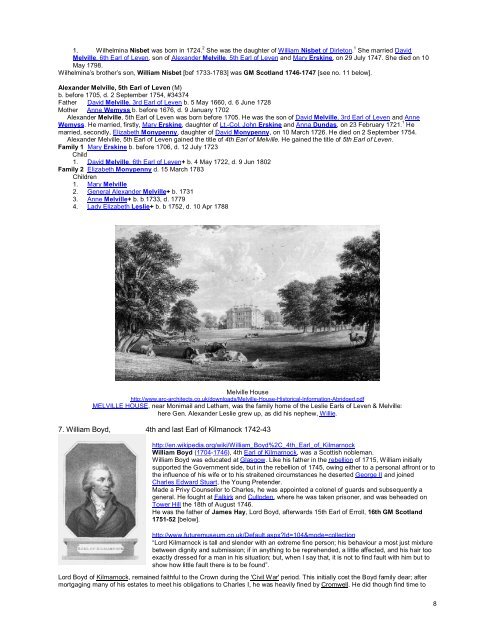Grand Masters of Scotland - Onondaga and Oswego Masonic ...
Grand Masters of Scotland - Onondaga and Oswego Masonic ...
Grand Masters of Scotland - Onondaga and Oswego Masonic ...
Create successful ePaper yourself
Turn your PDF publications into a flip-book with our unique Google optimized e-Paper software.
1. Wilhelmina Nisbet was born in 1724. 2 She was the daughter <strong>of</strong> William Nisbet <strong>of</strong> Dirleton. 1 She married David<br />
Melville, 6th Earl <strong>of</strong> Leven, son <strong>of</strong> Alex<strong>and</strong>er Melville, 5th Earl <strong>of</strong> Leven <strong>and</strong> Mary Erskine, on 29 July 1747. She died on 10<br />
May 1798.<br />
Wilhelmina’s brother’s son, William Nisbet [bef 1733-1783] was GM <strong>Scotl<strong>and</strong></strong> 1746-1747 [see no. 11 below].<br />
Alex<strong>and</strong>er Melville, 5th Earl <strong>of</strong> Leven (M)<br />
b. before 1705, d. 2 September 1754, #34374<br />
Father David Melville, 3rd Earl <strong>of</strong> Leven b. 5 May 1660, d. 6 June 1728<br />
Mother Anne Wemyss b. before 1676, d. 9 January 1702<br />
Alex<strong>and</strong>er Melville, 5th Earl <strong>of</strong> Leven was born before 1705. He was the son <strong>of</strong> David Melville, 3rd Earl <strong>of</strong> Leven <strong>and</strong> Anne<br />
Wemyss. He married, firstly, Mary Erskine, daughter <strong>of</strong> Lt.-Col. John Erskine <strong>and</strong> Anna Dundas, on 23 February 1721. 1 He<br />
married, secondly, Elizabeth Monypenny, daughter <strong>of</strong> David Monypenny, on 10 March 1726. He died on 2 September 1754.<br />
Alex<strong>and</strong>er Melville, 5th Earl <strong>of</strong> Leven gained the title <strong>of</strong> 4th Earl <strong>of</strong> Melville. He gained the title <strong>of</strong> 5th Earl <strong>of</strong> Leven.<br />
Family 1 Mary Erskine b. before 1706, d. 12 July 1723<br />
Child<br />
1. David Melville, 6th Earl <strong>of</strong> Leven+ b. 4 May 1722, d. 9 Jun 1802<br />
Family 2 Elizabeth Monypenny d. 15 March 1783<br />
Children<br />
1. Mary Melville<br />
2. General Alex<strong>and</strong>er Melville+ b. 1731<br />
3. Anne Melville+ b. b 1733, d. 1779<br />
4. Lady Elizabeth Leslie+ b. b 1752, d. 10 Apr 1788<br />
Melville House<br />
http://www.arc-architects.co.uk/downloads/Melville-House-Historical-Information-Abridged.pdf<br />
MELVILLE HOUSE, near Monimail <strong>and</strong> Letham, was the family home <strong>of</strong> the Leslie Earls <strong>of</strong> Leven & Melville:<br />
here Gen. Alex<strong>and</strong>er Leslie grew up, as did his nephew, Willie.<br />
7. William Boyd, 4th <strong>and</strong> last Earl <strong>of</strong> Kilmanock 1742-43<br />
http://en.wikipedia.org/wiki/William_Boyd%2C_4th_Earl_<strong>of</strong>_Kilmarnock<br />
William Boyd (1704-1746), 4th Earl <strong>of</strong> Kilmarnock, was a Scottish nobleman.<br />
William Boyd was educated at Glasgow. Like his father in the rebellion <strong>of</strong> 1715, William initially<br />
supported the Government side, but in the rebellion <strong>of</strong> 1745, owing either to a personal affront or to<br />
the influence <strong>of</strong> his wife or to his straitened circumstances he deserted George II <strong>and</strong> joined<br />
Charles Edward Stuart, the Young Pretender.<br />
Made a Privy Counsellor to Charles, he was appointed a colonel <strong>of</strong> guards <strong>and</strong> subsequently a<br />
general. He fought at Falkirk <strong>and</strong> Culloden, where he was taken prisoner, <strong>and</strong> was beheaded on<br />
Tower Hill the 18th <strong>of</strong> August 1746.<br />
He was the father <strong>of</strong> James Hay, Lord Boyd, afterwards 15th Earl <strong>of</strong> Erroll, 16th GM <strong>Scotl<strong>and</strong></strong><br />
1751-52 [below].<br />
http://www.futuremuseum.co.uk/Default.aspx?Id=104&mode=collection<br />
“Lord Kilmarnock is tall <strong>and</strong> slender with an extreme fine person; his behaviour a most just mixture<br />
between dignity <strong>and</strong> submission; if in anything to be reprehended, a little affected, <strong>and</strong> his hair too<br />
exactly dressed for a man in his situation; but, when I say that, it is not to find fault with him but to<br />
show how little fault there is to be found”.<br />
Lord Boyd <strong>of</strong> Kilmarnock, remained faithful to the Crown during the 'Civil War' period. This initially cost the Boyd family dear; after<br />
mortgaging many <strong>of</strong> his estates to meet his obligations to Charles I, he was heavily fined by Cromwell. He did though find time to<br />
8







![Richard [Nicholls] Harison / Harrison - Onondaga and Oswego ...](https://img.yumpu.com/24950065/1/190x245/richard-nicholls-harison-harrison-onondaga-and-oswego-.jpg?quality=85)

![Richard [Nicholls] Harison / Harrison - Onondaga and Oswego ...](https://img.yumpu.com/24950063/1/190x245/richard-nicholls-harison-harrison-onondaga-and-oswego-.jpg?quality=85)







